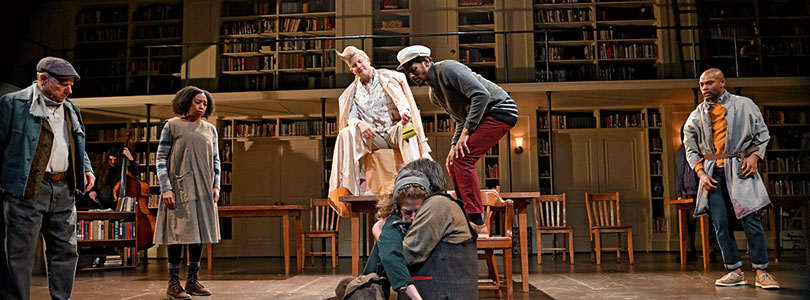Trinity Rep Theatrical Craft Brings the Subversion We Need
It was the most progressive of plays,
it was the most conservative of plays,
it played up Northeastern prejudices,
it could not downplay universal Truth.
Whatever else it was,
it was a stunning artistic achievement.
Driving into Providence to see A Tale of Two Cities at Trinity Rep with my college-bound daughter, I remarked on one of the great ironies of contemporary artistry. Namely, artists tend to be overtly radical in their politics and presentation, but art requires Truth, and Truth is implicitly conservative, at least in our post-post-modern, relativist society. Radicals have long since enshrined the cliché that art should be subversive, and in a fascinating way, we’ve reached the point that the conservative nature of Truth can make good art subversive of artists!
But before the philosophy, the presentation. Another point of conversation in the long, long journey into the capital city from the outskirts of Rhode Island was my anticipation of (and trepidation about) the stagecraft for two scenes from Charles Dickens’s novel: the stoppage at the fountain (where the Marquis’ carriage crushes a child) and the storming of the Bastille. How would a small production address these two challenges?
In both cases, the ensemble utilized theatrical abstraction to excellent effect. The production begins on a stage set as an orderly library, with the cast members alternating a recitation of the famous opening lines of the book (mimicked at the beginning of this essay) as if arguing about current events. Throughout the play, the actors intersperse narrative phrases about their actions as if reading from the book, and the library’s reading tables become props and choreographed representations of settings. The latter device is so well done that the use of the plain wood furniture to represent such plot-critical objects as the Marquis’ carriage seems intrinsic to the story, rather than a concession to a budget.
The opening debate scene, the narrative dialogue, the innovative use of the setting, and various other aspects that you should discover for yourself give the play the feeling of an intellectually curious troupe building a case for something. The actors aren’t so much preforming an adaptation of the novel as constructing an argument about it, hinged on Dickens’s assertion that “the period was so far like the present period.” Speaking allowed lines that seem as if they should have been bracketed as stage directions doesn’t seem like a gimmick, but rather like quotation of textual evidence.
Here is where the Trinity Rep company was more successful than, perhaps, they or most of their audience realized. The presentation of the Marquis incorporated a not-so-subtle reference to President Trump because… of course it did. Some among the French revolutionaries were wearing pink knitted pussyhats because… of course they were. And yet, a conservative in the audience couldn’t help but wonder whether those around him chortling at these political allusions felt at least a little uncomfortable at the shadow this casts on the popular, progressive narrative. When the revolutionaries exploded in frustration at the aristocracy’s disregard for the common people, did anybody else in the audience think the word, “deplorables”? (Google the reference if necessary.)
In the play, as in the novel, the revolutionaries do not come out looking very good. That is especially true as compared with the other thematic “city” of the plot: a love story/triangle. The wanton sacrifice of a hated Other in the name of radical rage juxtaposes as a slimy, sticky, bloody smear against the warm, meaningful glow of personal sacrifice in the name of love and marriage and parenthood and heritage.
Did the playwright and director mean this all as a warning to their peers that their movement may be going astray, or was it merely Truth subverting fashionable progressivism? (“Merely”!) For the intriguing possibility of a knowing wink, keep an eye out for a red baseball cap.
As to that production team, their achievement would have been impressive enough had the script been taken down from the canonical shelf, having been fleshed out in trial and error on stages across the world. The reality is more impressive. Playwright Brian McEleney and Director Tyler Dobrowsky are local talents at Trinity Rep whose theatrical experience in Rhode Island and (in McEleney’s case) time teaching Brown students have honed their understanding of their craft such that they could take the risks they did in A Tale of Two Cities and succeed.
One hopes they’ve put their vision to paper sufficiently that it can be published for use by other companies, particularly among students, who desperately need cause to consider and debate the literary subjects they so adeptly capture.
For now, A Tale of Two Cities is only showing through March 22, so don’t miss your chance to see it.




